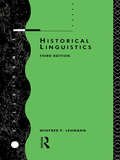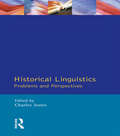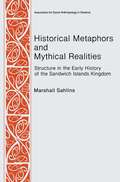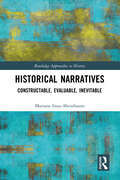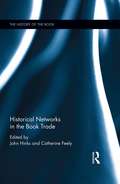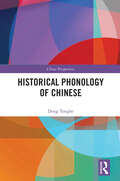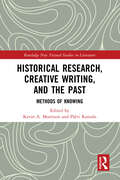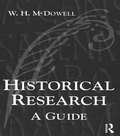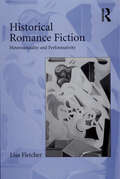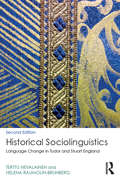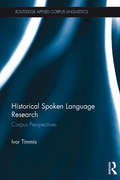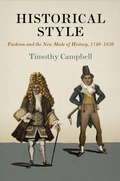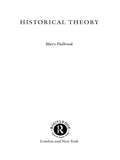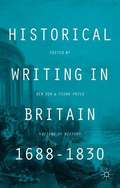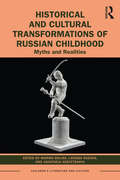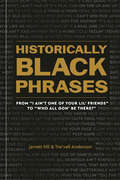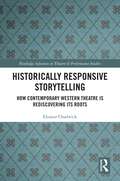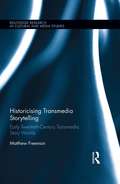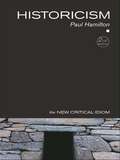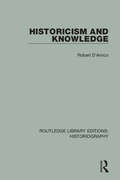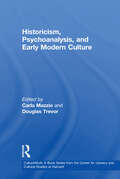- Table View
- List View
Historical Linguistics: An Introduction
by Winfred P. LehmannHistorical Linguistics provides a comprehensive and clearly written introduction to historical linguistic theory and methods. Since its first publication in 1962 the book has established itself as core reading for students of linguistics. This edition has been thoroughly revised. Drawing on recent linguistic and archaeological research Professor Lehmann incorporates key developments in the field. These include exciting advances in the history and development of writing: and in typological classification which allows better understanding of the structure of early languages. Well-illustrated with Indo-European examples, and supplementary exercises which draw on data from other language families as well, the book will enable students to carry out independent work in historical studies on any language family, as well as up-to-date work in Indo-European.
Historical Linguistics: Problems and Perspectives (Longman Linguistics Library)
by Charles JonesThe contributors to this volume cover the international range of scholarship in the field of Historical Linguistics, as well as some of its major themes. The work and ideas they discuss are relevant not only to other aspects of Historical Linguistics but also to more general developments in linguistic theory. Along with Professor Jones' Introduction, their comments provide a major overview of Historical Linguistics that will be the reference point for its development for many years to come and form an important contribution to general theories of linguistic behaviour.
Historical Metaphors and Mythical Realities
by Marshall SahlinsHawaiian culture as it met foreign traders and settlers is the context for Sahlins's structuralist methodology of historical interpretation
Historical Narratives: Constructable, Evaluable, Inevitable (Routledge Approaches to History)
by Mariana Imaz-SheinbaumThis book explains some of the psychological processes that go into narrative construction and why it is that we have so much variability of historical accounts about a single historical event. A central focus of this book is how historians go from having unconnected units of data to having a coherent, structured, and organized flow of experiences. The author argues that the way these connections are established responds to certain Gestalt psychological principles that allow us to understand not only how histories are constructed but also how this construction can be rather different depending on how these principles are applied. To illustrate how these principles are present in histories, the author analyzes classic historical writers such as Burckhardt, Huizinga, Vico, and Marx. As well as an explanation of why historical multiplicity happens, the book also offers a way to evaluate different historical narratives about the same historical event. To illustrate how the evaluative framework is at play, the author analyzes two views about the so-called discovery of America. The first one explains what happens in 1492 by using the term "discovery." The second one uses the notion of "invention" to talk about the same set of circumstances. The book provides an important epistemic tool to evaluate these different accounts—one that can be applied not only to this case but also others. This book appeals to scholars, graduate students, and upper-level undergraduate students of history and philosophy. In addition, the book may also attract intellectuals, generally considered, who are interested in how philosophy can inform and question historical practice.
Historical Networks in the Book Trade (The History of the Book)
by John Hinks Catherine FeelyThe book trade historically tended to operate in a spirit of co-operation as well as competition. Networks between printers, publishers, booksellers and related trades existed at local, regional, national and international levels and were a vital part of the business of books for several centuries. This collection of essays examines many aspects of the history of book-trade networks, in response to the recent ‘spatial turn’ in history and other disciplines. Contributors come from various backgrounds including history, sociology, business studies and English literature. The essays in Part One introduce the relevance to book-trade history of network theory and techniques, while Part Two is a series of case studies ranging chronologically from the Middle Ages to the twentieth century. Topics include the movement of early medieval manuscript books, the publication of Shakespeare, the distribution of seventeenth-century political pamphlets in Utrecht and Exeter, book-trade networks before 1750 in the English East Midlands, the itinerant book trade in northern France in the late eighteenth century, how an Australian newspaper helped to create the Scottish public sphere, the networks of the Belgian publisher Murquardt, and transatlantic radical book-trade networks in the early twentieth century.
Historical Parallels, Commemoration and Icons (Routledge Approaches to History)
by Andreas LeutzschHistorical parallels, analogies, anachronisms and metaphors to the past play a crucial role in political speeches, historical narratives, iconography, movies and newspapers on a daily basis. They frame, articulate and represent a specific understanding of history and can be used not only to construct but also to rethink historical continuity. Almost-forgotten or sleeping history can be revived to legitimize an imagined future in a political discourse today. History can hardly be neutral or factual because it depends on the historian’s, as well the people’s, perspective as to what kind of events and sources they combine to make history meaningful. Analysing historical analogies – as embedded in narratives and images of the past – enables us to understand how history and collective memory are managed and used for political purposes and to provide social orientation in time and space. To rethink theories of history, iconology and collective memory, the authors of this volume discuss a variety of cases from Hong Kong, China and Europe.
Historical Phonology of Chinese (China Perspectives)
by Dong TongheAs an important introduction to the phonological history of Chinese, this title explores the phonological systems of the Chinese language and explains basic concepts, materials and methodologies. Unlike many historical accounts, this book adopts a reverse chronological sequence – starting with the phonology of Modern Mandarin and modern Chinese dialects, then looking back on Early Mandarin and Middle Chinese, and ultimately ending with Old Chinese phonology. This arrangement makes the book reasonably approachable to both professionals and general readers, building up knowledge along an ascending order of difficulty, from familiar, observable facts to theoretical, speculative hypotheses. Based on the extant studies and two essential types of rhyme materials, the book reconstructs the speech sounds of Middle and Old Chinese, in terms of initials, finals and tones. It also analyses the transition and evolution of phonological systems of the Chinese language in different periods. Marking the beginning of historical Chinese phonological studies and drawing on modern Western linguistics, this book will serve as an essential read for students and researchers of Chinese language, Chinese linguistics and especially historical Chinese phonology.
Historical Research, Creative Writing, and the Past: Methods of Knowing (Routledge New Textual Studies in Literature)
by Kevin A. Morrison Pälvi RantalaAlthough historical research undertaken in different disciplines often requires speculation and imagination, it remains relatively rare for scholars to foreground these processes explicitly as a knowing method. Historical Research, Creative Writing, and the Past brings together researchers in a wide array of disciplines, including literary studies and history, ethnography, design, film, and sound studies, who employ imagination, creativity, or fiction in their own historical scholarship or who analyze the use of imagination, creativity, or fiction to make historical claims by others. This volume is organized into four topical sections related to representations of the past—textual and conceptual approaches; material and emotional approaches; speculative and experiential approaches; and embodied methodologies—and covers a variety of temporal periods and geographical contexts. Reflecting on the methodological, theoretical, and ethical underpinnings of writing history creatively or speculatively, the essays situate themselves within current debates over epistemology and interdisciplinarity. They yield new insights into historical research methods, including archival investigations and source criticisms, while offering readers tangible examples of how to do history differently.
Historical Research: A Guide for Writers of Dissertations, Theses, Articles and Books
by Bill McdowellThis is the first practical guide to cover the various stages of a history research project, from the selection of the topic and the organization and interpretation of source material, through to the completion of the written-up record.Whether it is for a dissertation, thesis article or, indeed, full-length book, Historical Research deals with the purpose of research, and the implications, limitations and benefits of different research methods, as well as the effective presentation of the finished result.
Historical Romance Fiction: Heterosexuality and Performativity
by Lisa FletcherThe first book-length study of romance novels to focus on issues of sexuality rather than gender, Historical Romance Fiction moves the ongoing debate about the value and appeal of heterosexual romance onto new ground, testing the claims of cutting-edge critical theorists on everything from popular classics by Georgette Heyer, to recent 'bodice rippers,' to historical fiction by John Fowles and A.S. Byatt. Beginning with her nomination of 'I love you' as the romance novel's defining speech act, Lisa Fletcher engages closely with speech-act theory and recent studies of performativity. The range of texts serves to illustrate Fletcher's definition of historical romance as a fictional mode dependent on the force and familiarity of the speech act, 'I love you', and permits Fletcher to provide a detailed account of the genre's history and development in both its popular and 'literary' manifestations. Written from a feminist and anti-homophobic perspective, Fletcher's subtle arguments about the romantic speech act serve to demonstrate the genre's dependence on repetition ('Romance can only quote') and the shaky ground on which the romance's heterosexual premise rests. Her exploration of the subgenre of cross-dressing novels is especially revealing in this regard. With its deft mix of theoretical arguments and suggestive close readings, Fletcher's book will appeal to specialists in genre, speech act and performativity theory, and gender studies.
Historical Sociolinguistics: Language Change in Tudor and Stuart England (Longman Linguistics Library #8)
by Terttu Nevalainen Helena Raumolin-BrunbergHistorical Sociolinguistics: Language Change in Tudor and Stuart England is the seminal text in the field of historical sociolinguistics. Demonstrating the real-world application of sociolinguistic research methodologies, this book examines the social factors which promoted linguistic changes in English, laying the foundation for Modern Standard English. This revised edition of Nevalainen and Raumolin-Brunberg’s ground-breaking work: discusses the grammatical developments that shaped English in the early modern period; presents the sociolinguistic factors affecting linguistic change in Tudor and Stuart English, including gender, social status, and regional variation; showcases the authors’ research into personal letters from the people who were the driving force behind these changes; and demonstrates how historical linguists can make use of social and demographic history to analyse linguistic variation over an extended period of time. With brand new chapters on language change and the individual, and on newly developed sociolinguistic research methods, Historical Sociolinguistics is essential reading for all students and researchers in this area.
Historical Spoken Language Research: Corpus Perspectives (Routledge Applied Corpus Linguistics)
by Ivor TimmisHistorical Research on Spoken Language: Corpus Perspectives uses historical sources to discuss continuity and change in spoken language. Based on two corpora compiled using data from sociological and anthropological studies of Victorian London and 1930s Bolton, the author shows how historical spoken corpora can illuminate the nature of spoken language as well as the attitudes, values and behaviour of the specific community represented in a corpus. This book: demonstrates how spoken language can be examined using material collected before the advent of sophisticated recording equipment and large-scale computerised corpora; shows how other written sources such as diaries, letters and existing historical corpora can be used to analyse informal language use as far back as the fifteenth century; provides insight into the longevity and resilience of many spoken language features which are often regarded as vernacular or non-standard; comes with a companion website which gives full access to the Bolton Worktown Corpus. Historical Research on Spoken Language is key reading for researchers and students working in relevant areas.
Historical Style: Fashion and the New Mode of History, 1740-1830 (Material Texts)
by Timothy CampbellHistorical Style connects the birth of eighteenth-century British consumer society to the rise of historical self-consciousness. Prior to the eighteenth century, British style was slow to change and followed the cultural and economic imperatives of monarchical regimes. By the 1750s, however, a growing fashion press extolled, in writing and illustration, the new phenomenon of periodized fashion trends. As fashion fads came in and out of style, and as fashion texts circulated and obsolesced, Britons were forced to confront the material persistence of out-of-date fashions. Timothy Campbell argues that these fashion texts and objects shaped British perception of time and history by producing new curiosity about the very recent past, as well as a new self-consciousness about the means by which the past could be understood.In a panoptic sweep, Historical Style brings together art history, philosophy, and literary history to portray an era increasingly aware of itself. Burgeoning consumer society, Campbell contends, highlighted the distinction between the past and the present, created an expectation of continual change, and forged a sense of history as something that could be tracked through material objects. Campbell assembles a wide range of writings, images, and objects to render this eighteenth-century landscape: commercial dress displays and David Hume's ideas of novelty as historical form; popular illustrations of recent fashion trends and Sir Joshua Reynolds's aesthetic precepts; fashion periodicals and Sir Walter Scott's costume-saturated historical fiction. In foregrounding fashion to trace eighteenth-century historicism, Historical Style draws upon the interdisciplinary, multimedia archival impressions that fashionable dress has left behind, as well as the historical and conceptual resources within the field of fashion studies that literary and cultural historians of eighteenth-century and Romantic Britain have often neglected.
Historical Theory
by Mary FulbrookPractising historians claim that their accounts of the past are something other than fiction, myth or propaganda. Yet there are significant challenges to this view, most notably from postmodernism. In Historical Theory, a prominent historian develops a highly original argument that evaluates the diversity of approaches to history and points to a constructive way forward. Mary Fulbrook argues that all historians face key theoretical questions, and that an emphasis on the facts alone is not enough. Against postmodernism, she argures that historical narratives are not simply inventions imposed on the past, and that some answers to historical questions are more plausible or adequate than others. Illustrated with numerous substantive examples and its focus is always on the most central theoretical issues and on real strategies for bridging the gap between the traces of the past and the interpretations of the present. Historical Theory is essential and enlightening reading for all historians and their students.
Historical Truth and Lies About the Past
by Alan B. SpitzerHistorians have long struggled with the questions of historical relativism, objectivity, and standards of proof and evidence. Intellectual historian Alan Spitzer focuses on the contradiction between theory and practice by presenting case studies of four politically charged debates about the past: the response to the report of the commission chaired by John Dewey that evaluated the accusations made against Leon Trotsky in the Moscow Purge Trials of 1937, the Dreyfus Affair in turn-of-the-century France, the allegations about the extent and meaning of literary critic Paul de Man's complicity with the German occupation forces in wartime Belgium, and Ronald Reagan's justification for his 1987 visit to a German cemetery where Nazi SS officers are buried. Spitzer's argument centers on the ways in which the authority of 'objective' criteria for historical judgment are introduced in politicized disputes about the past, regardless of the theoretical qualification or repudiation of such standards. The higher the political stakes, the more likely the antagonists are to appeal to generally warranted standards of relevant evidence and rational inference. Spitzer's commentary speaks to issues that transcend the specific content of the four cases he discusses.
Historical Writing in Britain, 1688–1830
by Ben Dew Fiona PriceHistorical Writing in Britain, 1688-1830 explores a series of debates concerning the nature and value of the past in the long eighteenth century. The essays investigate a diverse range of subjects including art history, biography, historical poetry, and novels, as well as addressing more conventional varieties of historical writing.
Historical and Cultural Transformations of Russian Childhood: Myths and Realities (Children's Literature and Culture)
by Marina Balina Larissa Rudova Anastasia KostetskayaHistorical and Cultural Transformations of Russian Childhood is a collection of multidisciplinary scholarly essays on childhood experience. The volume offers new critical approaches to Russian and Soviet childhood at the intersection of philosophy, literary criticism, film/visual studies, and history. Pedagogical ideas and practices, and the ideological and political underpinnings of the experience of growing up in pre-revolutionary Russia, the Soviet Union, and Putin’s contemporary Russia are central venues of analysis. Toward the goal of constructing the "multimedial childhood text," the contributors tackle issues of happiness and trauma associated with childhood and foreground its fluidity and instability in the Russian context. The volume further examines practices of reading childhood: as nostalgic text, documentary evidence, and historic mythology. Considering Russian childhood as historical documentation or fictional narrative, as an object of material culture, and as embodied in different media (periodicals, visual culture, and cinema), the volume intends to both problematize but also elucidate the relationship between childhood, history, and various modes of narrativity.
Historical and Cultural Transformations of Russian Childhood: Myths and Realities (Children's Literature and Culture)
by Marina Balina Larissa Rudova Anastasia KostetskayaHistorical and Cultural Transformations of Russian Childhood is a collection of multidisciplinary scholarly essays on childhood experience. The volume offers new critical approaches to Russian and Soviet childhood at the intersection of philosophy, literary criticism, film/visual studies, and history. Pedagogical ideas and practices, and the ideological and political underpinnings of the experience of growing up in pre-revolutionary Russia, the Soviet Union, and Putin’s contemporary Russia are central venues of analysis. Toward the goal of constructing the "multimedial childhood text," the contributors tackle issues of happiness and trauma associated with childhood and foreground its fluidity and instability in the Russian context. The volume further examines practices of reading childhood: as nostalgic text, documentary evidence, and historic mythology. Considering Russian childhood as historical documentation or fictional narrative, as an object of material culture, and as embodied in different media (periodicals, visual culture, and cinema), the volume intends to both problematize but also elucidate the relationship between childhood, history, and various modes of narrativity.
Historically Black Phrases: From "I Ain't One of Your Lil' Friends" to "Who All Gon' Be There?"
by jarrett hill Tre'vell AndersonA fun and thoughtful dictionary of Black language you didn&’t know you needed, Historically Black Phrases is a love letter to the Black community and the ways it drives culture.&“This perfect blend of explanation, definition and social commentary will have you laughing while learning.&”—George M. Johnson, New York Times bestselling author of All Boys Aren't Blue and We Are Not BrokenBlack vernacular doesn&’t often get its due—despite its enormous influence on mainstream culture—but Historically Black Phrases is here to give Black language its flowers. A celebration of more than two hundred staples of Black conversation—from church sayings and units of measure to compliments and reprimands—this sharp and witty guide explores the unique importance of Black expression and communication. Historically Black Phrases offers definitions and notable pop culture moments, as well as tips on pronunciation and usage of phrases like &“feelin&’ yourself,&” &“don&’t get it twisted,&” and &“pop off.&” In addition to the phrases, short essays offer insight on different facets of Black language from scholars, entertainers, and pop culture commentators (i.e., everybody and they mama). Authors, journalists, and hosts of the award-winning podcast FANTI, jarrett hill and Tre&’vell Anderson examine each phrase with humor and cultural precision, making Historically Black Phrases a vital ode to how Black language influences the world.
Historically Responsive Storytelling: How Contemporary Western Theatre is Rediscovering its Roots (Routledge Advances in Theatre & Performance Studies)
by Eleanor ChadwickThis book explores the notion that the emergent language of contemporary theatre, and more generally of modern culture, has links to much earlier forms of storytelling and an ancient worldview. This volume looks at our diverse and amalgamative theatrical inheritance and discusses various practitioners and companies whose work reflects and recapitulates ideas, approaches, and structures original to theatre’s ritual roots. Drawing together a range of topics and examples from the early Middle Ages to the modern day, Chadwick focuses in on a theatrical language which includes an emphasis on the psychosomatic, the non-linear, the symbolic, the liminal, the collective, and the sacred. This interdisciplinary work draws on approaches from the fields of anthropology, philosophy, historical and cognitive phenomenology, and neuroscience, making the case for the significance of historically responsive modes in theatre practice and more widely in our society and culture.Eleanor
Historicising Transmedia Storytelling: Early Twentieth-Century Transmedia Story Worlds (Routledge Research in Cultural and Media Studies)
by Matthew FreemanTracing the industrial emergence of transmedia storytelling—typically branded a product of the contemporary digital media landscape—this book provides a historicised intervention into understandings of how fictional stories flow across multiple media forms. Through studies of the storyworlds constructed for The Wizard of Oz, Tarzan, and Superman, the book reveals how new developments in advertising, licensing, and governmental policy across the twentieth century enabled historical systems of transmedia storytelling to emerge, thereby providing a valuable contribution to the growing field of transmedia studies as well as to understandings of media convergence, popular culture, and historical media industries.
Historicism (The New Critical Idiom)
by Paul HamiltonHistoricism is the essential introduction to the field, providing its readers with the necessary knowledge, background and vocabulary to apply it in their own studies. Paul Hamilton's compact and comprehensive guide: * explains the theory and basics of historicism* presents a history of the term and its uses* introduces the reader to the key thinkers in the field, from ancient Greece to modern times* considers historicism in contemporary debates and its relevance to other modes of criticism, such as feminism and post-colonialism* contains an extensive bibliography of further reading.
Historicism and Knowledge (Routledge Library Editions: Historiography)
by Robert D'AmicoA critical account of the case for historicism from Popper to Foucault, this volume, originally published in 1989, shows the viability of an historicist account of knowledge by replying to traditional objections and the need for defenses of realism and reference at the heart of most alternatives to historicism. The book provides insights to those in philosophy as well as literary criticism, intellectual history, history of science, and cultural criticism.
Historicism, Psychoanalysis, and Early Modern Culture (CultureWork: A Book Series from the Center for Literacy and Cultural Studies at Harvard)
by Douglas Trevor Carla MazzioFirst published in 2000. Did people in early modern Europe have a concept of an inner self? Carla Mazzio and Douglas Trevor have brought together an outstanding group of literary, cultural, and history scholars to answer this intriguing question. Through a synthesis of historicism and psychoanalytic criticism, the contributors explore the complicated, nuanced, and often surprising union of history and subjectivity in Europe centuries before psychoanalytic theory. Addressing such topics as "fetishes and Renaissances," "the cartographic unconscious," and "the topographic imaginary," these essays move beyond the strict boundaries of historicism and psychoanalysis to carve out new histories of interiority in early modern Europe.
Historicizing Colonial Nostalgia
by Patricia M.E. LorcinThis illuminating study of European women's narratives in colonial Algeria and Kenya argues that nostalgia was not a post-colonial phenomenon but was embedded in the colonial period. Patricia M. E. Lorcin explores the distinction between imperial nostalgia, associated with the loss of power that results from the loss of empire, and colonial nostalgia, associated with loss of socio-cultural standing—in other words, loss of a certain way of life. This distinction helps to make women's discursive role an important factor in the creation of colonial nostalgia, due to their significant contribution to the establishment of a European colonial environment.
